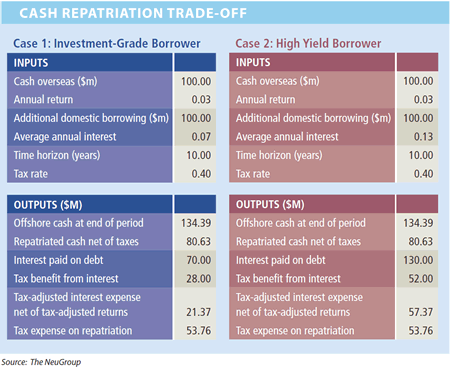By Dwight Cass
Despite taxes, there are times when it makes sense to bring it home.
The Obama administration decided against offering a new Homeland Investment Act as part of its stimulus package earlier this year. But companies with large amounts of cash overseas should consider whether it makes sense to bring it home anyway. Yes, they’ll pay full freight in terms of tax, rather than the token 5.25 percent they enjoyed for a year under the original HIA in 2005. But depending on their circumstances and timeframe, it may still be more economical to repatriate it.
That’s the message delivered by the chief investment officer for growth equity investments at a leading asset management firm, speaking at a panel discussion during The NeuGroup’s Tech20 Treasurers’ Peer Group Meeting last month. Companies should determine if the amount they pay in interest on domestic borrowings used to replace the cash, net of what they earn by investing their overseas profits, is bigger than the potential tax hit of bringing it home.
That may seem like a long shot. And for investment-grade companies that can borrow relatively cheaply, the tax hit is often the bigger threat. But for marginally investment grade borrowers, and certainly for many junk-rated concerns, the negative interest arbitrage can eventually swamp the tax advantage of keeping cash abroad. The higher a company’s cost of borrowing, the more likely—and rapidly—this will happen.
LESSER OF TWO EVILS
For example, take a single-A rated multinational with $100 million held by overseas subsidiaries, invested conservatively and earning 3 percent (Case 1, below). Assume that, because it doesn’t have access to its overseas cash, it issues $100 million of ten-year bonds with a 7 percent annual interest rate to plug that gap. For this company, it’s a no-brainer: the tax hit at the end of ten years would be higher than the negative interest arbitrage.
If it decided to repatriate at the end of ten years, it would have to pay nearly $54 million in taxes on the cash and compound interest it earned overseas, while having lost only about $21.5 million on the negative interest arbitrage over that period, after accounting for taxes.
By contrast, take a single-B company with the same amount of cash overseas that is invested in the same manner (Case 2, below). Say it floats bonds with a 13 percent coupon. All other things being equal, the cost of the negative interest arbitrage will outpace its tax hit in 10 years. (A spreadsheet that illustrates these calculations can be found by clicking the link below the table at the bottom of this story.)
This is only a crude starting point. The rate of overseas cash generation, interest rates, debt amortization, the company’s risk appetite, leverage, tax rate on the interest it earns and other issues will all bear on its decision. Also, this example assumes the cash is repatriated at the end of the period; if not, the time value of money would have to be accounted for.
However, as the investment manager noted, not all companies bother to do the math and think through whether they are putting themselves at a disadvantage by waiting and hoping for an HIA 2.0.
That’s looking increasingly far-fetched, given the political uproar following academic studies of the original HIA. That measure was meant to prompt companies to fund job creation, R&D and other economically stimulating activities. But research showed that nearly all the repatriated cash was paid out to shareholders.
With no HIA 2.0 in the cards, treasurers should examine the trade-off as things stand. However, there is a fly in the ointment. Calculating the trade-off requires one to tacitly assume that the company will simultaneously reduce its leverage. Given the uses of repatriated cash under the original HIA in 2005, that seems a bit of a stretch.
